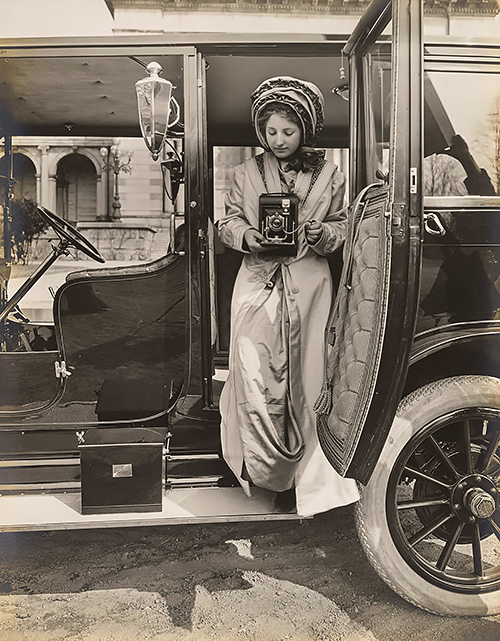Photo Corners headlinesarchivemikepasini.com
![]()
A S C R A P B O O K O F S O L U T I O N S F O R T H E P H O T O G R A P H E R
![]()
Enhancing the enjoyment of taking pictures with news that matters, features that entertain and images that delight. Published frequently.
American Chemical Society to Honor Kodak



27 September 2022
The American Chemical Society will honor George Eastman and the Eastman Kodak Company with the National Historic Chemical Landmark designation for making "photography feasible for everyone."

Kodak Ad. astman and Kodak's advances made photography consumer friendly, as seen in this Kodak ad from 1910. Courtesy of the George Eastman Museum.
"This Landmark honors George Eastman, Eastman Kodak and the many generations of Kodak chemists, scientists and engineers who made photography an everyday part of our lives before the advent of smartphones and digital cameras," said ACS President Angela K. Wilson, Ph.D. "Many of us remember the enjoyment of taking pictures, sending the film to be developed and waiting to see the printed photos."
ACS established the National Historic Chemical Landmarks program in 1992 to recognize seminal events in the history of chemistry and to increase awareness of the contributions of chemistry to society. Past Landmarks include the invention of Polaroid instant photography, the discovery and production of penicillin, the invention of synthetic plastics and the works of such notable scientific figures as educator George Washington Carver and environmentalist Rachel Carson.
The Kodak Landmark dedication ceremony will take place on Oct. 3 at 4:30 p.m. ET at the Kodak Center in Rochester, New York.
Kodak and Consumer Photography Earn Historic Chemical Landmark designation
WASHINGTON, D.C. -- When photography was in its infancy, it was a complicated and cumbersome process accessible to a select few. But thanks to innovations that began in the late 19th century, George Eastman and the Eastman Kodak Co. made photography feasible for everyone. On Oct. 3, the American Chemical Society will honor that achievement with the National Historic Chemical Landmark designation.
The Landmark dedication ceremony will take place at 4:30 p.m. ET at the Kodak Center in Rochester, New York.
"This Landmark honors George Eastman, Eastman Kodak and the many generations of Kodak chemists, scientists and engineers who made photography an everyday part of our lives before the advent of smartphones and digital cameras," says ACS President Angela K. Wilson, Ph.D. "Many of us remember the enjoyment of taking pictures, sending the film to be developed and waiting to see the printed photos."
But back in George Eastman's day, it was a different story. In 1878, he was planning a vacation to the Caribbean. He wanted to take photographs on the trip, so he bought a camera. But it was the size of a microwave oven. The chemicals and other supplies needed to prepare photographic plates, then capture and develop photos were even more cumbersome. The experience left him determined to find a better way.
Eastman modified the chemistry and equipment to make photography easier -- so easy that even a child could take photographs. The company he founded, Eastman Kodak, ultimately revolutionized photography. Thanks to the firm's advances, the size of cameras was reduced and film production and development was simplified. Millions of people worldwide captured memories using cameras and film, leaving all the chemistry to Kodak. The ease of this process was summed up by the company's slogan, "You press the button, we do the rest."
ACS established the National Historic Chemical Landmarks program in 1992 to recognize seminal events in the history of chemistry and to increase awareness of the contributions of chemistry to society. Past Landmarks include the invention of Polaroid instant photography, the discovery and production of penicillin, the invention of synthetic plastics and the works of such notable scientific figures as educator George Washington Carver and environmentalist Rachel Carson. For more information, visit http://www.acs.org/landmarks.